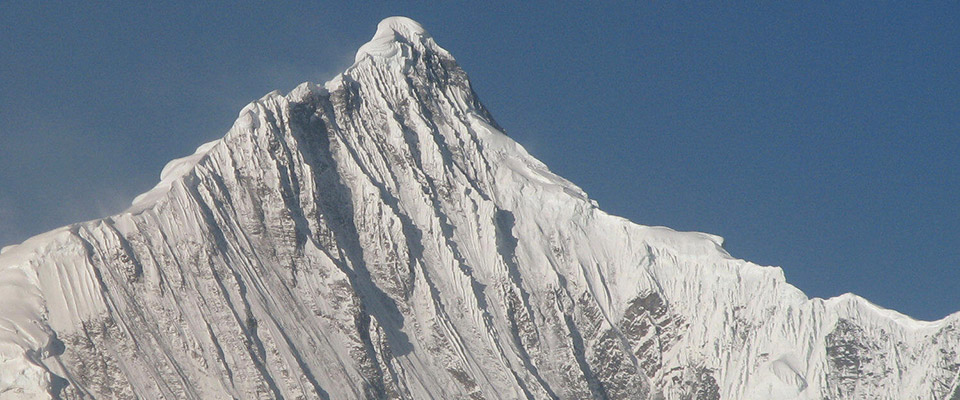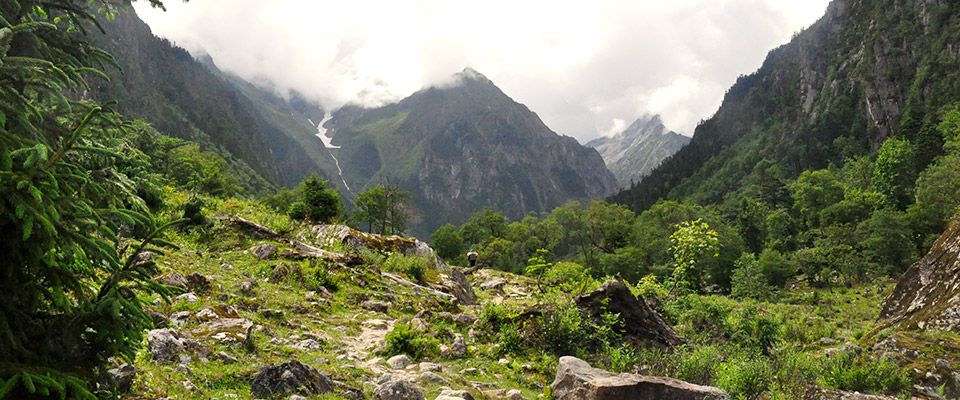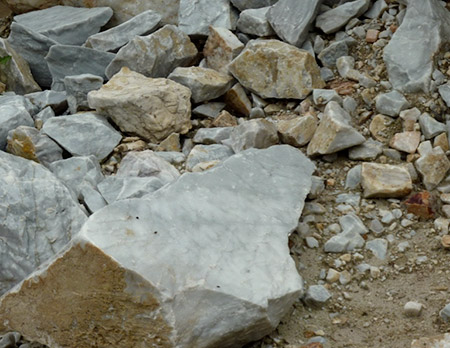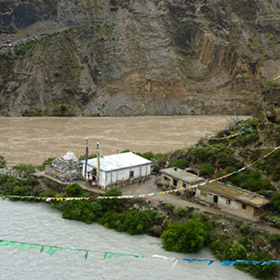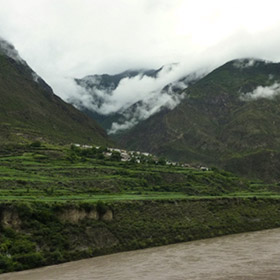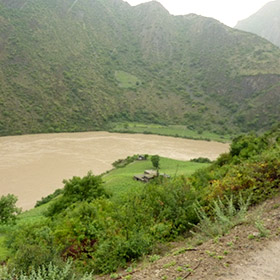Mt. Kawagebo huwa wieħed mill-aktar muntanji qaddisa rispettati u jirrappreżenta kultura importanti tan-Nofsinhar tat-Tibet. Kawa tfisser abjad u Gebo tfisser muntanja fil-lingwa Tibetana lokali. Il-muntanji Kawagebo għandhom klima kumplessa, kundizzjonijiet ġeoloġiċi u ekoloġiċi: Mill-wied l-iktar baxx tax-xmara sal-ogħla quċċata hemm differenza fl-għoli ta ' 4900 m, li joħloq ċinturini klimatiċi distinti: widien subtropikali tax-xmara niexfa sħuna, Muntanji temporali, Muntanji boreali u folji tas-silġ. It-tipi ta 'veġetazzjoni jvarjaw minn arbuxxelli niexfa, Foresti tal-muntanji subtropikali, Foresti boreali, Ħaxix alpini għal tundra highland. Filwaqt li ħafna mill-MT. Kawagebo, huwa nominat bħala żona protetta, il-parti tal-punent, li jkopri parti mill-prefettura ta 'Chayu tat-Tibet, mhix inkluża fil-park nazzjonali minħabba l-klima niexfa tiegħu u l-kopertura tal-veġetazzjoni skarsa.
Mt. Kawagebo kien oriġinarjament meqjus mit-Tibetani bħala d-dar ta 'Tsan, deità qawwija. Bil-wasla tal-Buddisti fir-reġjun madwar is-seklu 8, Id-Divinità nbidlet fi protettur tal-Buddiżmu, u ġie msejjaħ f'Kawagebo. Matul is-sekli, Ġew stabbiliti mogħdijiet ta 'pellegrina, li llum jinkludu postijiet naturali sagri differenti bħal korpi tal-ilma sagri (funtani, lagi u kaskati) u blat sagri (ġebel, Irdumijiet, għerien). Il-mogħdijiet tal-pellegrinaġġ jgħaqqdu postijiet sagri li jimbuttaw pajsaġġ sħiħ ma 'tifsira tas-sagrifiċċju. Postijiet bħal dawn jinkludu monasteri fejn patrijiet eminenti jgħaddu minn kultivazzjoni spiritwali.
Ir-raħħala Tibetani lokali li jgħixu madwar iċ-ċirku pellegrini jqisu l-muntanji bħala l-protettur tagħhom u għandhom serje ta’ metodi tradizzjonali ta’ ġestjoni tar-riżorsi naturali bħal ri-rgya, il-komunità muntanji qaddisa u żona tabù, fejn il-kaċċa u l-qtugħ tas-siġar huma strettament ipprojbiti. Fil- ri-rgya1, il-ġbir ta' prodotti tal-foresti mhux tal-injam, trobbija limitata u attivitajiet oħra jistgħu jkunu permessi. ri-rgya, jippermettu l-użu sostenibbli tar-riżorsi tal-komunità, protezzjoni tar-riżorsi tal-ilma, u l-prevenzjoni tal-erożjoni tal-għoljiet tal-muntanji, telf ta' ilma u ħamrija. Ir-ritwali u l-offerti jsiru mill-membri tal-familja maskili fir-reġjun: filgħodu kmieni tal- 5th, 10th, 15th u 30th tax-xahar. It-tul tar-ritwali u l-ammont ta 'offerti jvarjaw, il-quċċata per eżempju fl-ewwel jum tas-sena l-ġdida.
Politika u l-Liġi:
Mt. Kawagebo hija rregolata fil-qafas tal-politika nazzjonali. Żoni protetti magħżula jinsabu fil-qrib fejn il-governanza tista’ tibbenefika l-kundizzjonijiet ekoloġiċi tal-Mt. kawagebo.
Il-governanza tradizzjonali tal- ri-rgya hija waħda mill-aktar prattiċi reliġjużi importanti għall-komunità Tibetana lokali. Hemm ftehimiet bejn irħula u familji differenti biex jiggarantixxu r-riġenerazzjoni tal-injam u pjanti mediċinali, kif ukoll użu limitat ta’ riżorsi mhux rinnovabbli bħal blat u minerali.
Riżultati
Permezz tal-proġetti kulturali u ambjentali tal-KCC, in-nies lokali jifhmu dejjem aktar l-importanza tal-kultura u l-ambjent naturali tagħhom stess. Hemm aktar fiduċja kulturali fost ir-raħħala lokali kif ukoll żieda fl-integrità tal-komunità. Il-kollaborazzjoni ma' gruppi u organizzazzjonijiet oħra hija mtejba, u riċerka dwar il-muntanji u l-foresti tabù (ri-rgya) qed jibni pont bejn l-għarfien lokali u l-governanza nazzjonali kif ukoll ir-riċerka internazzjonali.
Il-viżjoni tat-Tibetan lokali mhix espliċita iżda tgħix fit-tradizzjoni spiritwali tagħhom. Mt. Kawagebo bħala muntanja sagra hija l-qalba tat-twemmin tan-nies lokali. Għalhekk l-għan huwa li jiġi kkonservat il-fiżiku, status kulturali u spiritwali tal-Mt. Kawagebo u twaqqaf il-qerda diretta jew indiretta fuq il-ġisem tal-muntanji u l-kultura tagħhom.
Koalizzjoni
Il-Klabb tal-Kultura Kawagebo (KCC) trid tippromwovi l-kultura folkloristika Tibetana u tipproteġi l-ambjent ekoloġiku u kulturali lokali, Imma huma wkoll jippruvaw jippromwovu l-kultura tradizzjonali u l-kunċett tal-konservazzjoni tan-natura għat-Tibetani lokali. KCC, Irreġistrat fi 1999 f'Deqin, Kapitali tal-Awtonomija Tibetana Diqing f'Yunnan, hija organizzazzjoni bla skop ta 'qligħ imwaqqfa minn Silang, Kap Liberjan Tibetan ta 'Deqin u Artist. Din l-organizzazzjoni tiffoka fuq il-promozzjoni tal-kultura Tibetana billi tagħti korsijiet ta 'strumenti ta' lingwa u mużika b'xejn u tidħol gradwalment fiż-żona ta 'protezzjoni ambjentali.
Ir-raħħala lokali huma megħjuna minn organizzazzjonijiet internazzjonali bħall-konservazzjoni tan-natura, Konservazzjoni Internazzjonali u PCD. Il-gvern DeQin u voluntiera minn postijiet oħra joffru wkoll appoġġ sostanzjali.
Azzjoni
Peress 2003, Il-Kawagebo Culture Club iwettaq azzjonijiet differenti biex tqajjem il-kuxjenza dwar il-problemi lokali u s-soluzzjonijiet tagħhom. Eżempji huma inċentivi kontra żejjed, Proġetti ta 'riċerka konġunta, Proġetti ta 'tindif taż-żibel u protezzjoni ta' speċi ta 'annimali lokali u speċi ta' annimali.
Ir-raħħala qed jorganizzaw ftehim madwar l-irħula ta 'MT. Kawagebo Pilgrim Circle, Biex tiċċara l-pożizzjoni tagħhom kontra l-minjieri fir-reġjun. Minkejja oppożizzjoni mill-forzi fin-negozju u fil-gvern, Ir-raħħala huma fuq gwardja biex jiffaċċjaw inċertezzi futuri rigward il-postijiet sagri u r-riżorsi naturali tagħhom.
- Tibetani Village waqfiet Minjieri fuq Muntanji Sagra, Il-Sacred Land Film Proġett. Artikolu Ara
- Chan, K.-Man & Zhou, Y., 2007. Opportunità politika u moviment ta 'kostruzzjoni kontra d-diga fiċ-Ċina. Fil-pp. 1-27.
- Kannella, P., Magee, D. & Xu, Y., 2008. Vulnerabilità soċjoekonomika fl-iżvilupp tal-idroenerġija taċ-Ċina. Reviżjoni Ekonomika taċ-Ċina, 19(4), pp.614-627. Żur l-artiklu
- Gongbu, Dorje, 2004. M.A.. Ċirku tal-Pan-Culture ta 'MT. Kawagebo u sfond storiku, Università Minzu taċ-Ċina. Żur il-Website
- U (Xmajjar Internazzjonali), 2007. Nujiang Map Xmajjar Internazzjonali. Żur il-Website
- My J., 2007, Siti naturali sagri u konservazzjoni bijoloġika fir-reġjun ta 'Kawagebo, L-10 Laqgħa tan-Netwerk tar-Riżerva tal-Bijosfera tal-Asja tal-UNESCO MAB (Eabrn 10)
- Tbs, Bureau tat-Tibet tal-Istatistika, 2007. Yearbook Statistiku tat-Tibet 2007: Bureau tat-Tibet tal-Istatistika. Beijing: Kumpanija tal-Pubblikazzjoni Statistika taċ-Ċina, 2007.
- Magazine Ritorn, 2010, Kawagebo Culture Club. Żur il-Website
- Każ ta 'Studju: Il-Siti naturali Sagra ta 'Kham, Tibetani Reġjun Awtonomu, Ċina. Żur il-Website

